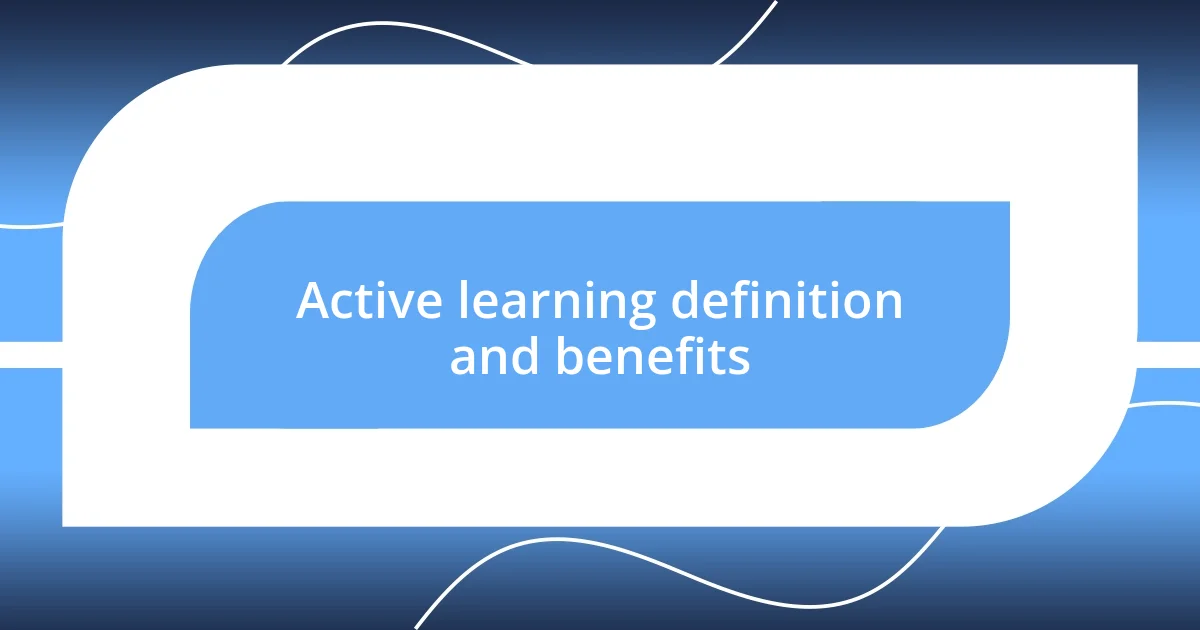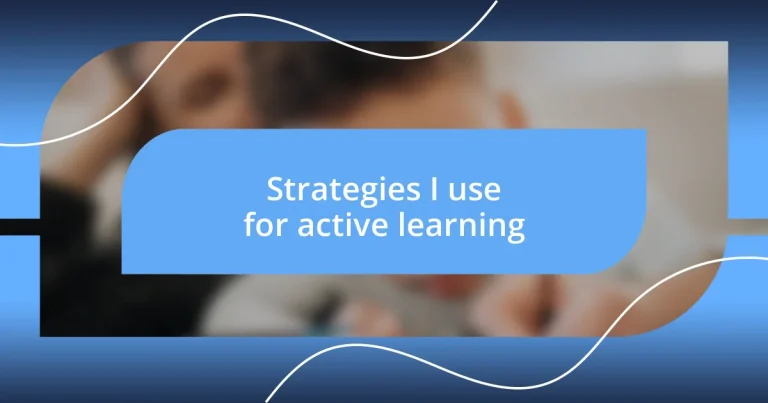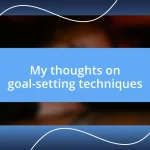Key takeaways:
- Active learning enhances engagement, critical thinking, retention, and fosters collaboration and communication skills among students.
- Utilizing diverse learning resources (e.g., textbooks, podcasts, online courses) enriches understanding and creates a dynamic learning experience.
- Regularly measuring and adjusting learning strategies, along with reflecting on experiences, is essential for growth and effective learning outcomes.

Active learning definition and benefits
Active learning can be defined as an educational approach where students engage in the learning process through hands-on experiences, discussions, and problem-solving. I remember when I first dove into this style of learning; it was a revelation! Instead of passively receiving information, I was actively involved and it made the content so much more memorable.
The benefits of active learning extend far beyond just increased engagement. It fosters critical thinking and improves retention, as I learned during group projects where we debated concepts and challenged each other’s ideas. Have you ever found yourself immersed in a discussion that just clicks? That moment of understanding feels entirely different from rote memorization.
Moreover, active learning cultivates collaboration and communication skills. During a recent workshop, I witnessed firsthand how sharing diverse perspectives not only enhanced our collective understanding but also built camaraderie among participants. Isn’t it fascinating how learning together can create not just knowledge, but also connections?

Setting clear learning goals
Setting clear learning goals is absolutely vital for guiding the active learning process. When I set specific, measurable objectives, it transforms my approach to each study session. For example, while preparing for a recent exam, I pinpointed three key areas I needed to master. This clarity not only boosted my confidence but also helped me allocate my study time effectively, ensuring I tackled the most important topics head-on.
Here are some effective strategies that I find helpful for defining clear learning goals:
- Break down larger goals into smaller, manageable tasks.
- Use the SMART criteria (Specific, Measurable, Achievable, Relevant, Time-bound) to create your goals.
- Regularly review and adjust your goals based on progress and new insights.
- Share your goals with a study buddy to enhance accountability and support.
- Reflect on your achievements to celebrate your progress and motivate yourself further.
By embracing this approach, I’ve noticed that not only does my engagement with the material increase, but I also feel a deeper sense of accomplishment as I tick off each goal along the way.

Utilizing diverse learning resources
Utilizing diverse learning resources is something I’ve come to appreciate deeply. I love exploring various tools and materials that provide different perspectives on a subject. For instance, I remember when I was studying psychology; I supplemented my textbooks with podcasts, documentaries, and even online forums. This blend enriched my understanding and made the learning process far more dynamic and enjoyable.
One of my favorite strategies is to mix traditional resources with modern technology. While textbooks provide foundational knowledge, interactive online courses can spark real curiosity. I once enrolled in a virtual course that included interactive quizzes and video lectures. It didn’t just complement my reading; it turned the material into a lively conversation where I could apply what I learned instantly. Have you ever felt a topic come alive through a different medium? That’s the magical experience diverse resources can provide.
Lastly, collaborating with peers is another way I enhance my learning through diverse sources. Organizing study groups where everyone shares their unique findings has been eye-opening. When my friends brought in their favorite articles and videos, it transformed our discussions into a treasure trove of insights. This collaborative approach not only expanded our collective knowledge but also fostered a supportive learning environment. I often feel energized by these sessions because they remind me that learning doesn’t have to be a solitary journey; it’s a shared adventure.
| Learning Resource | Benefits |
|---|---|
| Textbooks | Provide structured, foundational knowledge. |
| Podcasts | Offer expert insights and narrative storytelling. |
| Online Courses | Encourage interactivity and flexibility. |
| Study Groups | Enhance collaboration and diverse perspectives. |

Implementing collaborative learning techniques
Implementing collaborative learning techniques has really transformed how I perceive study sessions. I remember one semester when I teamed up with a few classmates to tackle a particularly challenging project. Instead of meandering through our notes alone, we divided the topics among us and came together to discuss our findings. It was remarkable how each person brought a unique perspective, turning what could have been tedious into a vibrant exchange of ideas. Have you ever experienced that moment when a discussion leads to a breakthrough? It’s exhilarating!
In my experience, setting up a structured approach for group work can significantly enhance the effectiveness of collaboration. We always made sure to assign roles based on each member’s strengths—someone as the researcher, another as the organizer, and a third as the presenter. This division not only clarified responsibilities but also allowed us to dig deeper into our respective areas. I recall a time when my detail-oriented friend took charge of compiling our research while I had the opportunity to focus on crafting the final presentation. Did it take pressure off? Absolutely! It was incredible to see how our combined efforts created a seamless end product that showcased our joint hard work.
To maintain engagement during collaborative sessions, I find it helpful to incorporate tech tools for real-time brainstorming. Apps like Google Docs allow everyone to contribute ideas simultaneously, turning our virtual workspace into a dynamic hub of creativity. Once, while preparing for a group presentation, we used a shared document and highlighted different sections, which brought our ideas to life like never before. Seeing everyone’s thoughts evolve right before our eyes energized the group and made us feel more connected. How do you keep your group interactions lively? For me, integrating technology is a game changer that encourages participation and sparks new ideas.

Incorporating technology in learning
In my journey of incorporating technology into learning, I’ve discovered that tools like virtual reality (VR) can dramatically enhance understanding. I remember attending a VR workshop where we explored ancient civilizations. It felt as if I was wandering through time, experiencing the culture first-hand. Have you ever immersed yourself in a different world while learning? That’s the captivating power that technology can hold.
Using educational apps has also become a staple in my study routine. I once started using a flashcard app that allowed me to test myself on vocabulary daily. Not only did it make memorization engaging, but the gamified elements kept me motivated. It’s like turning study time into a fun challenge! Have you tried mixing learning with play? I highly recommend it if you haven’t; it elevates what could be a mundane task into an exciting quest for knowledge.
Analytics tools have proven invaluable for tracking my progress. I once utilized a learning platform that provided insights into my strengths and areas for improvement. Being able to see those metrics was a game changer; it helped me focus my efforts more effectively. How often do we wish we had clearer direction in our studies? With the right technology, clarity becomes achievable, guiding us toward our learning goals in a more structured way. It’s fascinating how a bit of data can lead to meaningful change, isn’t it?

Reflecting on learning experiences
Reflecting on our learning experiences can be a powerful tool for growth. I often take a moment after completing a project or course to think about what worked well and what didn’t. For instance, I remember diving into a subject that initially seemed daunting. As I unpacked the concepts, I jotted down my feelings of confusion and clarity. Revisiting this reflection later allowed me to appreciate how far I’ve come and solidified that understanding in my mind. Isn’t it interesting how revisiting past challenges helps illuminate our progress?
Another aspect I find incredibly valuable is discussing these reflections with peers. There was a time when I shared my insights during a study group session, and it sparked a rich conversation. We all began to share our pitfalls and breakthroughs, creating a supportive environment. I realized that each person’s unique perspective provided insights I hadn’t considered. Have you ever had an “aha” moment simply because someone else shared their experience? Those moments are truly illuminating and foster a sense of camaraderie among learners.
Writing down my reflections has also become an integral part of my learning process. I maintain a learning journal where I record my thoughts after significant experiences. One day, I reflected on how a difficult math problem pushed me out of my comfort zone. Putting my feelings on paper helped me process my anxiety and ultimately reinforced my learning. Do you think maintaining a reflective practice could enhance your comprehension? I’ve found that it deepens my connections with the material and serves as a reminder of my growth journey.

Measuring and adjusting strategies
Adjusting strategies is where the real magic happens in active learning. For instance, after using a specific study method for a few weeks, I remember feeling frustrated because my progress plateaued. I took the time to analyze what wasn’t working and decided to tweak my approach—switching from passive reading to more interactive practice tests. This shift reignited my enthusiasm and led to a noticeable improvement in my retention. Isn’t it fascinating how a little adjustment can make a big difference?
I also believe that feedback plays a crucial role in refining our strategies. Once, during a peer review session, my classmate pointed out that my presentations lacked engagement. It stung at first, but I took it to heart and started incorporating more visual aids and storytelling elements in my next project. The audience’s response was encouraging! It’s a reminder that sometimes outside perspectives can help us see the blind spots we didn’t even know existed. Have you ever experienced a moment where feedback transformed your approach?
Finally, I’ve learned the importance of regularly assessing my goals. There was a period when I was juggling multiple subjects, and I felt overwhelmed. By taking a step back and evaluating my priorities, I realized I needed to focus on one thing at a time. I started to set weekly goals instead of grand ones, which felt more achievable. This simple adjustment not only alleviated my stress but also allowed for deeper learning in each area. How often do we overlook the power of small, incremental changes? It’s those adjustments that truly shape our learning experiences!













